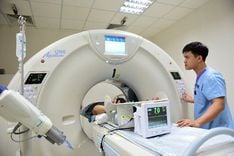This is an automatically translated article.
Bone cancer occurs when progenitor cells that develop bone divide out of control and form a tumor. Anyone can get bone cancer, but it is a common cancer in children and adolescents, especially teenage boys. Bone tumor surgery is one of the basic therapies in the treatment of bone cancer.
1. What is bone cancer?
Bone cancer is a rare type of cancer. There are about 750-900 new cases diagnosed each year in the United States. Osteosarcoma is the term for a type of bone cancer. The word osteosarcoma comes from two words osteo, meaning "of bone," and sarcoma, a general type of cancer. Bone cancer is the most common cancer in children and adolescents. It usually affects the bones of the legs and arms. In adults, common sites of osteosarcoma are the hip, shoulder, and jaw. Normal cells called progenitor cells will turn into fully developed fibrous tissue, cartilage or bone over time. But, if these cells begin to multiply and divide abnormally, they can cause tumors. Bone cancer forms if normal bone cells begin to divide abnormally and form a tumor. Survival rates are close to 70% for patients with osteosarcoma that have not metastasized. If the osteosarcoma has spread to more than one part of the body, the survival rate drops to 30% to 50%. Therefore, early detection and prompt treatment are extremely important for bone cancer.
2. How to determine the stage in bone cancer?
Staging is a way to find out how severe a cancer is. The most widely used system for staging bone cancer was developed by the American Joint Committee on Osteopathic Cancer (AJCC). This classification combines tumor size, histology, and metastasis to lymph nodes or other sites in the body to determine staging. Staging indicates how far the tumor has spread, how far it has spread, and helps guide the patient's optimal treatment. The stage of osteosarcoma is described as "localized" or "metastatic". Localized means that the tumor is still in the bone, and metastatic osteoma means that the tumor has spread to other parts of the body. Osteosarcoma spreads to other parts of the body through the tissue, lymphatic, and blood systems. Your doctor will ask you to do some tests to find out the stage of the cancer. For bone tumors, the tests that may be ordered are:
General physical exam Imaging: to determine the stage of bone cancer, the doctor may order some types of imaging such as imaging X-ray, CAT scan (CT scan), Positron emission tomography (PET), magnetic resonance imaging (MRI). Biopsy: A biopsy takes cells from a cancer or part of a tumor to see what type of cancer it is and what stage it is in. There are two types of biopsies commonly used in bone cancer: Core biopsy: A hollow-centred needle is used to remove a portion of tissue. Surgical biopsy: Surgery done to remove all or part of the tumor
3. Surgical methods used in the treatment of osteosarcoma
Treatment of bone cancer is a multimodal therapy, combining chemotherapy, radiation and surgery. The goal of surgery for bone cancer is to remove all of the cancer cells and minimize damage to other areas. The type of surgery will depend on the location of the tumor and the stage of the bone cancer. There are different types of osteosarcoma surgery commonly used including:
Surgery to remove only the tumor and preserve the limb: When osteosarcoma affects the leg or arm, the surgeon will try to save most of the function. function and appearance of the limb by performing limb-conserving surgery. The surgeon will perform the removal of the tumor, followed by the insertion of a graft, bone, or artificial bone/metal implant into the affected area. However, not all patients are able to perform surgery to remove the tumor and preserve the extremities. The choice of surgical method will depend on the location, size and extent of the tumor. Surgery to remove the affected limb (amputation): Today with the advancement in surgery has made the need for amputation much less over the years. If amputation is necessary, advances in prosthetic technology can significantly improve a patient's motor function. Surgery to remove the lower part of the leg (rotational surgery): The surgeon removes the tumor and the knee joint. The surgeon will then attach the rest of the leg and create a new knee joint using the ankle. The foot will point backward, and the ankle will act as a knee joint. The doctor will use prostheses for the lower leg and foot. The results usually help the patient perform very well in exercise, sports and daily activities. This type of surgery is sometimes used for children who are still growing. Note: For tumors that affect other parts of the body (not the extremities), the surgeon usually tries to remove as much of the cancer cells as possible, while leaving the affected bone. affect. You may need a graft (skin or bone taken from another area of your body) and/or a prosthetic leg.
4. What are the risks associated with bone cancer surgery?
As with any surgery, there are possible risks and side effects during bone cancer treatment, including:
Reactions to anesthesia : Reactions may include wheezing wheezing, rash, swelling and low blood pressure. Bleed. Blood clot formation. Infection. Pain. Problems with prosthetic implants. Long-term physical problems
5. How to recover after surgery for bone cancer
Recovery from osteosarcoma surgery will depend on the type of surgery you had. You will be given instructions on how to care for the incision, about the medications you will use, such as pain relievers, anticoagulants, etc. You may need a family member or friend to help with the surgery. daily routine until fully recovered. Some tips to help you recover faster include:
Make sure to take your medication as prescribed to prevent pain, infection and/or constipation. There are many ways to manage constipation after surgery. You can change your diet, drink more water, and take over-the-counter medications. Deep breathing and rest can help manage pain, keep the lungs healthy after anesthesia, and promote good lymphatic drainage. Try to do breathing and relaxation exercises a few times a day for the first week. For example, while sitting, close your eyes and take 5-10 deep breaths and relax your muscles. In conclusion, bone cancer is a rare but extremely dangerous disease. Early detection and treatment improve survival rates and reduce recurrence. You need to follow the doctor's instructions, maintain an optimistic spirit, and live a healthy lifestyle to deal with this terrible disease.
Please dial HOTLINE for more information or register for an appointment HERE. Download MyVinmec app to make appointments faster and to manage your bookings easily.













